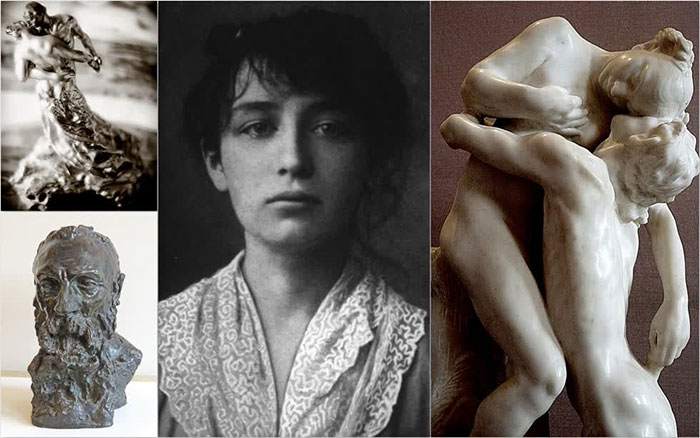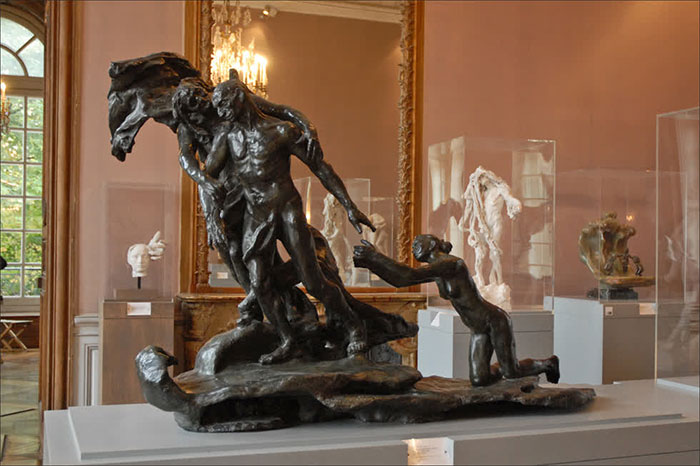Camille Claudel - Talented sculptor and a tearful fate
The sculptor Camille Claudel whose works are tearful evidence for her life.
Camille Claudel (December 8, 1864 - October 19, 1943) was a French sculptor. She is the sister of poet and diplomat Paul Claudel and colleague and lover of sculptor Auguste Rodin .
Nearly a century passed, until 1988, only when the film about the life of Camille Claudel was released, more than 70 works left in the countless works that were canceled by her own to find the right position. propriety and worthy in world art history.
Born in 1864, growing up in the small village of Villeneuve-sur-Fère in France, little girl Camille soon discovered the miracle of clay, under her small hands can make all shapes. After leaving home to Nogent sur Seine, she was quickly noticed by the young sculptor Alfred Boucher, taking on the role of a pupil and leading him into the sculpting path.

Camille Claudel (center) and her famous works.
The influence of the first teacher manifested in the 13-year-old Paul Claudel (1881) was a bronze statue of her younger brother (later the famous French poet and writer). When Camille was 18 years old, Boucher suddenly left France for Italy, introducing her to a famous sculptor in Paris. That is Auguste Rodin.
Rodin was 42 years old, living with Rose Beuret and having a son just two years younger than Camille. The meeting drew two talented artists into the whirlwind of intense love affair. Camille's hand was imprinted on many of his works during this period.
The public disdain unwarranted, gossip about Camille's works, saying that it is the teacher's creation. Despised and shunned by her mother and family, she must face repeatedly with Rodin's former lover, Camille, who lost her balance. In 1893, after deciding to officially break up with her lover, she closed herself in a sculpture workshop while Rodin was overwhelmed with world-class orders.

The work of Adulthood, cast in 1913 in Claudel's room at Musée Rodin (The character behind, tied in his own hair, Clotho, 1893).
At this time, she asserted herself with many works: Little Girl Châtelaine (1896), Waves (1897), Depression , Fortune (1900), Flute Woman (1904), Abandonment (1905) ) . The works are made in many versions with different materials: plaster, marble, copper, and she does not hesitate to use rare materials like marble to make a difference with Rodin. The delicate sensibility of her detailed research, her style of internal tearing, has stirred criticism.
The van is a work that transcends ordinary aesthetic value, expressing a strong love of two bodies full of vitality immersed in the world of rhythm and music. The sensuality of two hands only 'touching' without grasping, supporting arms, gentle but a reliable fulcrum created by the girl's stance, leaning back but leaning back with a little distance, let us feel the desire to wrap our dancing partners.

Artwork Van van.
The inner vitality of the work, through her meticulous hands, is reflected in the ethereal elegance of the muscles, the tremor of the cell. The intimacy of the two faces pushed emotionally and passionately to the desire to vanish in seemingly endless loops, as evidenced by the swirls of the rugged covered cloth swirling with them. like a shroud, with the technique of light, dark, floating, sink making contrast, torn: love or death? An intense sadness emanates from that.
Despite the distance, Rodin still maintains his practical support with his lover. He discreetly wrote to the Ministry of Industry proposing to export marble materials to help her, constantly introducing her to famous critics. However, critics who admire the statues are much skeptical of her style because they feel there is a hopelessly tired woman who wants to drop herself into art, an eccentric woman lost balance.

Muse'e Camille Claudel was opened in March 2017, is a national museum of France dedicated to Claudel's work.It is located in the teenage town of Nogent-sur-Seine.Musée Camille Claudel exhibits about half of the remaining 90 works of Claudel.
In 1898, Camille wrote to the Art Institute asking for a grant to do the Bronze Age . The inspector has approved and confirmed this is a worthy work. But just a few months later, during an exhibition, Rodin stumbled upon the original plaster version, angry that his private life was exposed to the public.
Without any explanation, not only did the sponsorship of the bronze version continue, but even the order for the marble version was canceled. The relationship of two people completely ended from there. Camille resented Rodin who caused all this misfortune.
There is no sculpture that the fate of a broken love affair so painful. An old woman, her face wrinkled, austere like death was putting her arms around the man and pulling him away, lovingly but fiercely. The man's left shoulder leaned back anxiously, but the right shoulder was warmed by the woman's heart sagging, resigned. The hand regretting letting go of the girl kneeling down in front of the empty space, pleading.
Except for the small but sculpted hands to see the hard work of a sculptor, her entire body, skin, and smooth breasts all exuded the beauty of youth. Writer Paul Claudel, her younger brother looking back at this statue cried: oh, no way, that pathetic girl, it is my sister, my dear Camille!
This beautiful, proud woman, again naked, knelt at her feet pleading and humiliating. Everything is over! She left the image of her life like that! That is her soul, her talent, her life, her beauty, her life and her name.
Seeing the statue from an objective perspective, beyond the private life of the artist, Maturity reflects an impermanence: people will one day have to leave youth to go back to the arid land. , coldness of old age and death. Camille has dedicated her heart to the work.
Creativity does not make her forget suffering, immersed in despair, loneliness, poverty, obsessions, dreams, paranoid delusions, she hammered countless of her works and many letters. other.
In 1913, Camille Claudel lost her mind completely, and was taken to the mental hospital of Ville Evrard. She died here on October 19, 1943, after thirty years of imprisonment, never fulfilling the longing that she confessed in the wake of a coma: how happy it would be if I could return to my home. Childhood at Villeneuve!
- Crazy Horse's stone face
- Attempt to restore the tomb of the famous sculptor Michelangelo
- FATE - An early warning device for the elderly
- Coincidence or fate arranged
- Discover two sculptures of the sculptor Michelangelo
- Beautiful parents often give birth to their first daughter
- Archimedes fate fate
- Many people think cancer is due to fate
- The talented students of the year of Pig
- Unfold the horrifying fate of the beauty god Aphrodite
- Testosterone determines human fate
- Date of birth affects each person's fate?
 The most famous scientific failures in history
The most famous scientific failures in history Mysterious genius mechanic and the machine froze time
Mysterious genius mechanic and the machine froze time The son carries the 'bad gene' of genius Albert Einstein
The son carries the 'bad gene' of genius Albert Einstein Isaac Newton
Isaac Newton